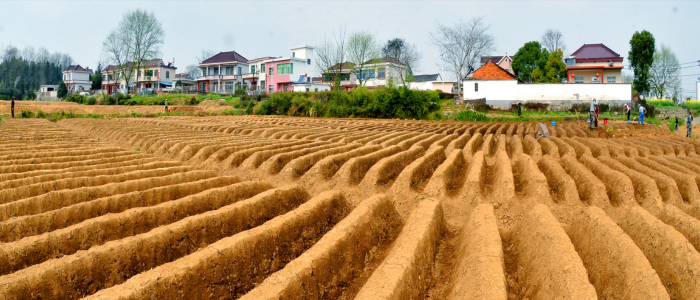Sistema de cultivo de jengibre blanco de Tongling en la provincia de Anhui, China
SIPAM desde 2023

Global Importance
Tongling people make ingenious use of local resources and pay respect to the theories and methods of ecological agriculture, ensuring the sustainability of local agricultural production system and stability of economy and society, and making the system itself a successful story of sustainable small-scale farming. Nature-based solutions to ecological and environmental problems, food and nutrition security issues, and human health care can provide the international community with experience and wisdom in tackling global challenges. Therefore, the unique ginger cultural landscape that has emerged from Tongling’s characteristic natural environment, climate, and soil contributes to the diversity of farming culture worldwide.
Food and livelihood security
Agricultural products, such as rice, white ginger, oilseed rape, and other vegetables, produced by the Tongling White Ginger Plantation System provide local people with abundant and diversified food and nutrients, and guarantee the food security of this region. The medical and health-enhancing functions of Tongling white ginger safeguard local people’s nutrition and health. Multifunctional agricultural development promotes local economic development and increases farmers’ income.
Agrobiodiversity
Southern China is the principal ginger-planting area, while Tongling is an important part of this southern planting area. There are 17 varieties of ginger in the Tongling White Ginger Plantation System, and white ginger is the main variety. Semi-late rice is the main crop for rice cultivation in Tongling, with fewer early-season and late rice varieties. There are 31 main varieties of rice.
Tongling White Ginger Plantation System is a natural complex that consists of plants, animals, microflora, and abiotic environment. It realizes various ecological functions through circulation of matter and energy flow between internal elements, and between the System and the ambient environment.
Local and traditional knowledge systems
Tongling has developed a systematic technology and knowledge for ginger plantation, including key techniques such as ginger pavilion for seed-preserving and germination-accelerating and white ginger planting techniques. Ginger farmers have developed a series of methods for prevention and treatment of three common diseases and insect pests for white ginger, ginger wilt, ginger worm, and Prodenia litura.
There are a large number of processing techniques, which are passed down over nearly 1,000 years, for Tongling white ginger, such as Salt-pickled Ginger, Sauced Ginger, Sweet-and-Sour Ginger, and Sugared Ginger.
Cultures, value systems and social organizations
A characteristic ginger culture has emerged from time-honoured ginger cultivation in Tongling, blending itself into all aspects of local life. For example, ginger planting, ginger food, ginger gifts, belief in Ginger God, and Ginger Zen. Fresh ginger is made into pickled ginger, sweet-and-sour ginger, candied ice ginger, and honeyed ginger after various methods of processing, yielding pastries, hospitality snacks, and great gifts for local people. Ginger-ridge treading is the most arduous work among all processes of white ginger planting. Mastery of ginger-ridge treading skills used to be an important criterion for local women to choose their husbands. A ginger-pavilion opening ceremony is held every year when the pavilion is reopened, and people sing pavilion-opening chants to salute the Ginger God. Tongling people worship Yanju, the god of ginger. Buddhist culture of Ginger Zen is prevalent in this region.
The seeding of ginger is not conducted by farmer themselves. Seeding experts who run ginger pavilions are entrusted by farmers with the task of seed preserving and germination accelerating.
Landscapes and waterscapes features
The microtopographical features of ginger ridges on high plots, in the Tongling white ginger plantations, constitute a unique landscape of ginger fields. Ginger is interspersed with rice, vegetables, and rivers as in a mosaic picture. Together, they form an amazing hill-field landscape with ginger fields/paddy fields. The riverside white ginger/ paddy planting area, with water and fields inlaid with each other, has a special watery glamor to it.
Moreover, over the long history of the Tongling white ginger production system, a special landscape of buildings has taken shape. It features special ginger workshops and ginger-culture-related ancient buildings. For example, the Ginger Trading Street in Ancient Datong Town, Dashi Temple in Datong Town, which has witnessed Tongling ginger farmers’ arduous journey of ginger planting, production and trade for hundreds of years.

